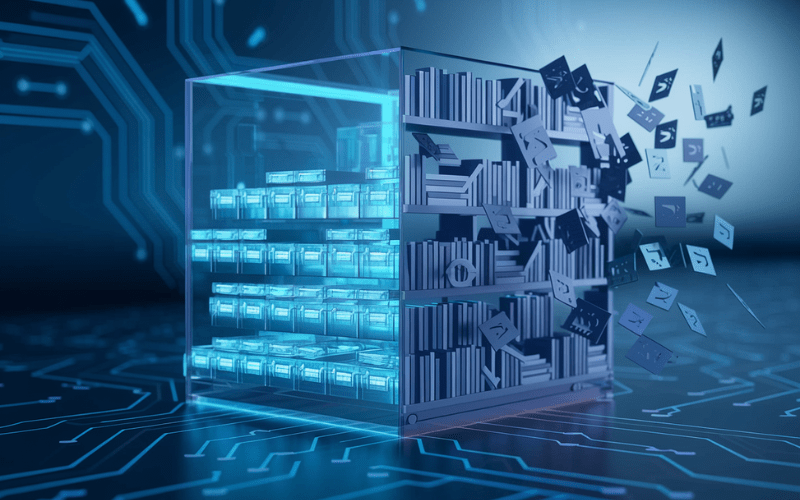Artificial intelligence has been in the headlines in recent times, and for good reason - it’s a powerful document processing tool for almost every type of business.
One particular subset of AI promises to revolutionise how we do business — deep learning paired with OCR. By harnessing the power of advanced machine learning algorithms, deep learning OCR is changing the way we handle data processing decision-making.
From improved accuracy and efficiency to enhanced document management, deep learning OCR tools are becoming the gold standard for document processing.
Here are the 5 key ways in which deep learning OCR is reshaping business workflows and unlocking new opportunities.
What Is Optical Character Recognition (OCR)?
In simple terms, OCR is the process of converting printed or handwritten text from images or scanned documents into machine-readable and editable formats.
The primary purpose of OCR is to streamline and automate data entry processes. It eliminates the time-consuming task of manual transcription and data entry, enabling businesses to digitise and extract valuable information more efficiently and accurately.
The roots of OCR can be traced back to the mid-20th century when early attempts were made to develop systems capable of recognising printed characters.
These early systems relied on pattern recognition techniques and simple algorithms to identify and interpret text from scanned images.
However, OCR technology has come a long way since then thanks to significant advancements in computing power, image processing algorithms, and the emergence of deep learning techniques.
OCR has found applications in various industries, including finance, healthcare, legal, retail, and logistics.
- In banking and finance, OCR facilitates the automated processing of receipts, invoices, and financial statements.
- In healthcare, it enables the efficient extraction of patient information from medical records.
- In the legal sector, OCR simplifies document indexing and retrieval.
- In recruitment, OCR can parse resumes and automate search and match processes.
What Is Deep Learning?
Deep Learning is an advanced subset of machine learning that leverages artificial neural networks to enable computers to learn and make decisions without explicit programming.
Inspired by the structure and functioning of the human brain, these deep learning algorithms learn from large amounts of data to recognise patterns, extract meaningful features, and make predictions or classifications.
Neural networks, composed of interconnected layers of artificial neurons also known as nodes or units, are the building blocks of deep learning.
Each node takes inputs, applies mathematical transformations, and produces an output. The connections between these various nodes have associated scoring weights that are adjusted during the learning process to optimise the network's performance.
In deep learning, neural networks are used to model complex relationships and hierarchies within data. Deep neural networks consist of multiple hidden layers, allowing them to learn progressively abstract representations of the input data as they process it.
This hierarchical representation enables deep learning models to capture intricate patterns and extract high-level features.
How Does Deep Learning-based OCR Processing Work?
Deep learning algorithms, particularly neural networks, have revolutionised OCR by mimicking the human brain's ability to learn and recognise patterns.
By training these neural networks on vast amounts of labelled data, OCR systems can now achieve remarkable accuracy in text recognition and extraction. This performance is consistent even when dealing with complex fonts, varying layouts, and degraded or low-resolution images.
Common deep learning algorithms used in OCR tools include:
- Convolutional Neural Networks (CNNs): CNNs are particularly effective in image recognition tasks, making them a popular choice for OCR applications. These networks automatically learn and extract visual features from images through a series of convolutional and pooling layers. Consequently, they excel at capturing local patterns and spatial relationships to enable accurate text detection and character recognition.
- Recurrent Neural Networks (RNNs): RNNs are specialised neural networks that can process sequential data, making them suitable for OCR tasks that involve ordered text, such as reading lines or paragraphs. These networks maintain an internal memory or "hidden state" that helps them capture context and dependencies between successive elements in a sequence. This memory enables RNNs to handle variable-length inputs and perform tasks such as handwriting recognition and text generation.
Other techniques such as long short-term memory (LSTM) networks, attention models, and transformer networks have also shown promising results for further improving accuracy and efficiency.
5 Ways DL-based OCR is Changing Business Workflows
As innovation leaders strive to stay ahead in today’s competitive business landscape, more and more leaders are adopting deep learning OCR to optimise their workflows.
Consequently, many of the benefits of this new technology are now becoming non-negotiable rather than a nice to have.
In particular, these are 5 areas where DL-based OCR is changing business workflows:
1. Improved Accuracy and Efficiency
Accuracy and efficiency play a critical role in ensuring smooth business operations and delivering high-quality outputs. The key advantage of deep learning OCR is its ability to achieve higher accuracy in text recognition and extraction.
Traditional OCR techniques often struggle with complex fonts, distorted images, or low-quality scans which lead to errors during character recognition. However, deep learning OCR models have overcome many of these challenges by learning from vast amounts of labelled data.
These models can discern intricate patterns and variations in characters, resulting in more precise and reliable text recognition. This improvement means that you can accurately process and convert documents such as invoices, receipts, or forms into digital formats with minimal errors. As a result, there is a significant reduction in manual data entry which is prone to mistakes.
Additionally, deep learning OCR can speed up the data capture process through automation.
Traditional methods often require manual intervention at various stages, from document sorting to data entry, leading to delays and bottlenecks. With DL-based OCR, you can automatically scan, process, and transform documents into structured digital data at a fraction of the time it would take to do it through manual means.
This saves valuable time and eliminates manual data entry, allowing employees to focus on more value-added activities such as analysis, decision-making, or customer service.
2. Enhanced Document Management
Traditionally, organising and categorising large volumes of documents was labour-intensive and time-consuming. However, with the help of advanced algorithms and neural networks, deep learning OCR enables you to automatically sort and classify documents, and the extracted data, and speed up document retrieval and search functions.
Traditional methods often rely on manual indexing or keyword-based searches, which can be limited and time-consuming. Deep learning OCR, on the other hand, enables intelligent indexing and search functionalities based on the content of the documents themselves.
Users can search for specific words, phrases, or even concepts across their entire document repository, retrieving relevant documents in a matter of seconds. This significantly improves the efficiency of information retrieval, enabling you to quickly locate and access the documents you need to carry out your tasks.
Additionally, it reduces the risk of losing important documents as you can store your digitised documents across multiple databases, ensuring that vital information is readily available.
3. Accelerated Decision Making
DL-based OCRs can analyse and understand the content of documents such as financial statements or feedback forms and then extract relevant data points with high accuracy and speed.
With the automation of this process, you can gain a deeper real-time understanding of customer sentiments, preferences, and needs. You can then leverage this information to personalise products and services, tailor marketing campaigns, and improve the overall customer experience.
For example, in financial institutions, deep learning OCR can swiftly extract key financial data from invoices or receipts, allowing for instant validation and processing. This accelerates financial workflows, such as accounts payable or expense management, enabling faster payments and reducing bottlenecks.
Similarly, in healthcare settings, deep learning OCR can extract patient information from medical records or prescriptions in real-time. This enables healthcare professionals to quickly access crucial patient data, leading to faster diagnoses, treatment decisions, and improved patient care.
You can also leverage the extracted data to generate real-time insights and reports to enable data-driven decision-making. For example, retail companies can quickly extract and analyse customer feedback to identify trends, preferences, and potential issues, allowing them to make prompt adjustments to their products or services.
4. Cost Savings and Resource Optimisation
One of the significant advantages of deep learning OCR is the reduction of time-consuming and error-prone manual labour. With deep learning OCR, you can rapidly process documents, allowing for faster turnaround times and better operational efficiency.
Not only does this labour reduction lead to immediate cost savings, but it also allows employees to focus on higher-value tasks.
Instead of spending valuable time on repetitive and mundane tasks, you can assign employees to projects that require their specialised skills and expertise. This improves overall resource utilisation and ensures that human talent is maximised for tasks that contribute to innovation and business growth.
Furthermore, deep learning OCR minimises the risk of human errors that can lead to financial discrepancies, customer dissatisfaction, or compliance issues. By leveraging the accuracy of deep learning algorithms, you can significantly reduce the occurrence of these errors and their associated costs.
5. Enhanced Customer Experience
Deep learning OCR gives you the ability to accelerate response times to customer enquiries and requests.
Through the automation of data extraction and processing, you can quickly extract relevant information from support tickets, such as the nature of the enquiry. This allows customer service representatives to access critical data in real-time, allowing them to efficiently respond to customer needs.
The reduction in manual data entry and processing time ensures that customers receive timely and accurate responses, enhancing their overall experience.
Deep learning OCR also contributes to better service quality.
By automating data extraction and eliminating manual errors, you can enjoy a higher level of accuracy in customer-related processes. This reduces the likelihood of mistakes in areas such as order processing, billing, or account management, which can lead to customer dissatisfaction and frustration. Seamless integration with customer-facing applications is another aspect that enhances the customer experience.
You can integrate deep learning OCR technology into various customer touchpoints, such as online portals, mobile applications, or self-service kiosks. This enables customers to easily upload and submit documents, such as identification documents, forms, or receipts, using their preferred channels.
Deep learning OCR processes these documents in real-time, extracting the necessary information and integrating it into the relevant systems or applications. This streamlines the customer experience, eliminates the need for manual document handling, and reduces the time required for data entry and document verification.
Deep Learning OCR Is the New Golden Standard
With the help of advanced machine learning algorithms and neural networks, deep learning OCR offers a range of benefits that are now becoming essential for businesses across industries.
It offers you better accuracy and efficiency through its ability to learn like a human. It improves document management through digitisation. And it drives improvements in both top and bottom-line revenue thanks to its ability to support better customer experiences and reduce unnecessary manual labour.
All of this makes deep learning OCR a must-have tool for all businesses looking to optimise their operations.
To experience the power of deep learning OCR, try Affinda. By combining natural language processing, computer vision, and deep learning, our AI-powered document processor goes above and beyond your traditional OCR.
Whether you need to process specialised financial documents, sensitive data, or something else, our deep learning OCR technology has you covered.
Sign up for a free trial of Affinda today to streamline your business workflows and improve your data management.











